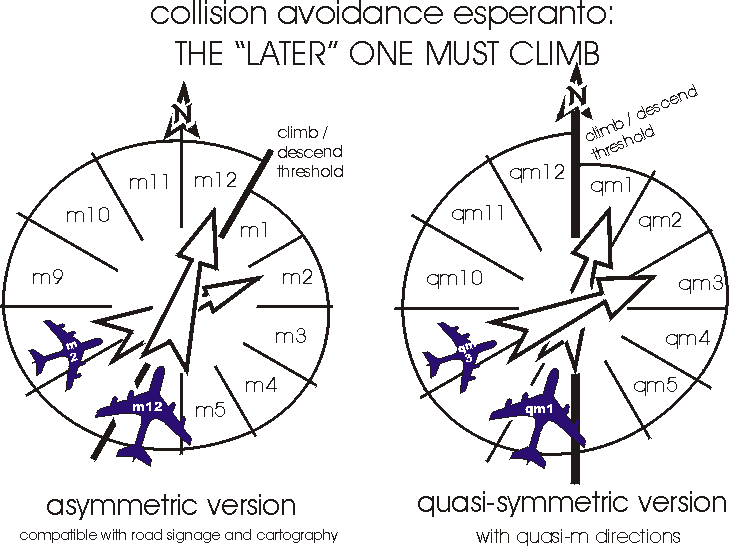
To
ICAO, Canada a/c sr. Renato Claudio Costa Pereira, secretario geral
and
EUROCONTROL, Bruxelles c/o Mr. John Law, ACAS Programme Manager
.
.
Collision Avoidance Esperanto acc. to the Munich Orientation Convention
====================================================
Dear Renato Claudio, dear Mr. Law,
as a german-brazilian inventor, I've developed an orientation system for average people to simplify and harmonize
- indoor and outdoor signage,
- cartography
and
- navigation electronics.
Please find a short description below. Acc. to www.watchrose.de , this system also allows to build natural world coordinates. It can also help to minimize right/left confusions and, in my opinion, the danger of collisions on air. After reading a TCAS specification, I apply for the introducion of the following convention concerning climb/descend advisories:
1 - TCAS = last resort tool
====================
I confirm that pilots should follow the TCAS advisories just in last case, that means, when no other logic is possible; for instance when the radio communication is disturbed.
2 - silence is golden
===============
The TCAS logic ist somehow complicated. In stress situations as at the Bodensee, the tower operator hardly will be able to follow this logic and give the same advisories. For such cases, it would be safer to forbid the operator sending climb/descend advisories. Instead of that, the next convention should be prefered.
3 - Orientation esperanto for emergency / stress / panic situations
================================================
In accordance with the Munich Orientation Convention, I apply for the following esperanto:
3.1
Flight direction = clock direction
========================
As a preparation for emergency situations, pilots should always keep the own flight direction in mind also as a clock direction as follows:
m12 = to north (0 ... 29)
m3 = to east (90 to 119)
m6 = to south (180 ... 209 )
etc. The reasonable division of space in 12 main directions is called time-space convention and is already known from air traffic emergency advisories. For m-directions acc. to the Munich Orientation Convention, the division is horizontal and corresponds exactly to the hour hand: 11:59h for instance, is earlier than 12:00h and in our brains belongs to 11 o'clock ( the old trick: EUR 1,99 seems to be a lot cheaper than EUR 2,-).
To avoid confusions on ground, this asymmetric convention should be the same as for the road signage and cartography, see www.follow-m.com/map and www.watchrose.com.
This recommendation isn't full compatible to the division for semi-circular cruising levels. If in your opinion this would constitute a problem, there is the possibility to redefine the m-directions to quasi-m-directions according to annexed picture.
Now the most important:
3.2
climb/descend esperanto
===================
In case of danger of collision - at least when both airplanes fly horizontal - , the following convention should be valid
THE "LATER" ONE MUST CLIMB
This can easily be memorized through the helix association "later = higher". Attention: m12 is "later" than m1 !!
The pilot who flyes in direction m12 (or qm12) knows all the time that he would be predestinated to climb ( no other can fly "later" ), the one who flyes in direction m1 (qm1) knows that he automatically would have to drop.
-------------------------
In my opinion, this tool would contribute to reduce the danger of collisions and also to tranquilize pilots, tower operators and the population. If this also seem reasonable to you, then I ask you for your support commanding the activities which may be necessary for an international penetration.
Concerning the rights-to-use, I expect that all interested corporations would sign a simple agreement acc. to www.follow-m.com/license. The fees are quasisimbolical and should be seen also as a membership fee. Acc. to §9, any secondary ideas will be remmunerated. The agreement also allows to use all tools for indoor signage, e. g. logical addressing of runways, buildings, rooms or fire extinguishers, natural signage for visitors etc.
